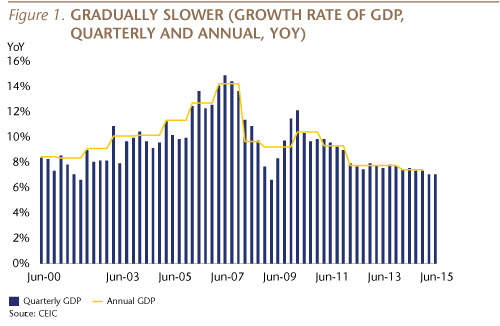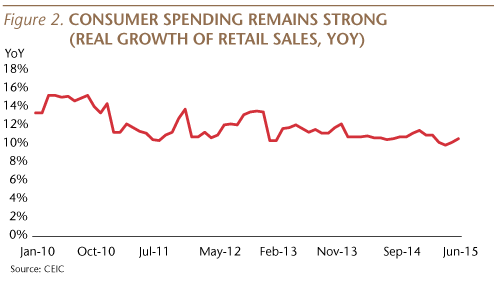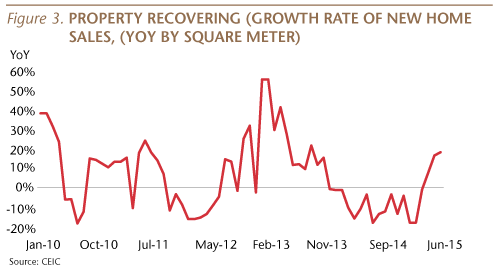Sinology: China's Rebalancing Continues
By Andy Rothman
The rebalancing of China’s economy continued in the second quarter of this year, as services and consumer spending drove more growth than industry and construction. The inevitable deceleration of most year-on-year (YoY) growth rates also continued, but a booming stock market provided a temporary lift to headline GDP growth.
Broking Lift
China’s GDP growth of 7% YoY for 2Q15—level with the 1Q15 pace and down from 7.5% in 2Q14—was greeted skeptically by some observers, but is the result of a strong contribution from the broking industry as the domestic stock market correction began only in the second half of June. (Monthly turnover on all of the domestic exchanges rose 607% YoY in 2Q15, compared to 8% during 2Q14.) Keep in mind that despite the recent sell-off, the Shanghai Stock Exchange Composite Index (SHCOMP) was still up 18% from the start of the year and 84% from a year ago, as of its July 15 close.
We estimate that the *tertiary part of the economy, which includes the financials sector as well as other services, rose by almost 9% YoY in the second quarter, while the secondary part, which includes manufacturing and construction, rose by less than 6% YoY. This is likely to be the third consecutive year in which the tertiary part of China’s economy will be larger than the secondary part.
But with the domestic stock market in retreat—the SHCOMP was down 26% from its June 12 peak, as of July 15—the broking boost is gone and we expect GDP growth to be a bit slower in the second half of this year.

World's Best Consumption Story
More importantly, the consumption story remains strong. Chinese officials said that consumption accounted for 60% of China’s GDP growth in the first half of the year, the largest share in six years.

The real (inflation-adjusted) growth rate of retail sales was 10.6% in June, the fastest pace in four months and close to last June’s 10.7%. Online retail sales of goods rose 39% YoY during 1H15, which is remarkable given the 48% growth rate during the first half of last year.
Nonetheless, we should anticipate that while China’s consumer spending numbers will remain very healthy, they will decelerate on a YoY basis, as real income growth is cooling a bit, to 7% in 2Q15 from 7.9% in 2Q14. Income for the 174 million migrant workers, who move from the countryside to cities to staff most of China’s construction and manufacturing jobs, rose 9.8% on a nominal basis (not adjusted for inflation) in 1H15, compared to 10.3% a year ago.
Property Stabilizing
The residential property market continued to recover in recent months, with new home sales up 18% on a square meter basis last month, compared to a decline of 4% during June of 2014. Last month was the second consecutive month of double-digit growth in new home sales, the first time that has happened since late 2013. And financing rules remain strict, with buyers required to put down cash equal to at least 30% of the purchase price.

The stock of unsold homes remains high, however, so new home starts were down 16% last month. This is a good thing, signaling that developers are sensibly cautious, but it does contribute to slower growth in investment and construction jobs.
Another factor that contributed to 7% GDP growth in the second quarter was the resumption of work on public infrastructure construction. The Communist Party’s anticorruption campaign appeared to have led many local officials to delay signing contracts (based on the theory that an inactive official could not be accused of corruption), but this problem seems to have been reduced, and we estimate that the growth rate of infrastructure investment rose to about 20% in June, up from about 15% in May. While not a stimulus, we expect this to be a stabilizing factor for the economy in the second half of the year.
Strong Spending on 'Soft' Infrastructure
The stronger macro numbers in June were matched by faster growth in fiscal revenue, which was up 14% last month, compared to an increase of only 5% in May.
The government continued to accelerate spending on “soft” infrastructure during the first half of the year, which is an important part of the economic rebalancing program. Government spending on education rose 13% YoY during the first half, while spending on health care rose 18% and environmental protection spending was up 20%.
Looking ahead, we expect the services and consumption parts of the Chinese economy to remain strong, although YoY growth rates are likely to continue to decelerate gradually. We expect GDP growth rates will also resume their gradual deceleration in the second half of this year, with full-year GDP growth in the 6.5% to 7% range—quite healthy, especially given the size of the base.
Andy Rothman
Investment Strategist
Matthews Asia
*Industries defined as:
Primary industry refers to agriculture, forestry, animal husbandry and fishery and services in support of these industries
Secondary industry refers to mining and quarrying, manufacturing, production and supply of electricity, water and gas, and construction
Tertiary industry refers to all other economic activities not included in the primary or secondary industries, including real estate, finance, wholesale and retail, transportation and other service industries
Back to Thought Leadership